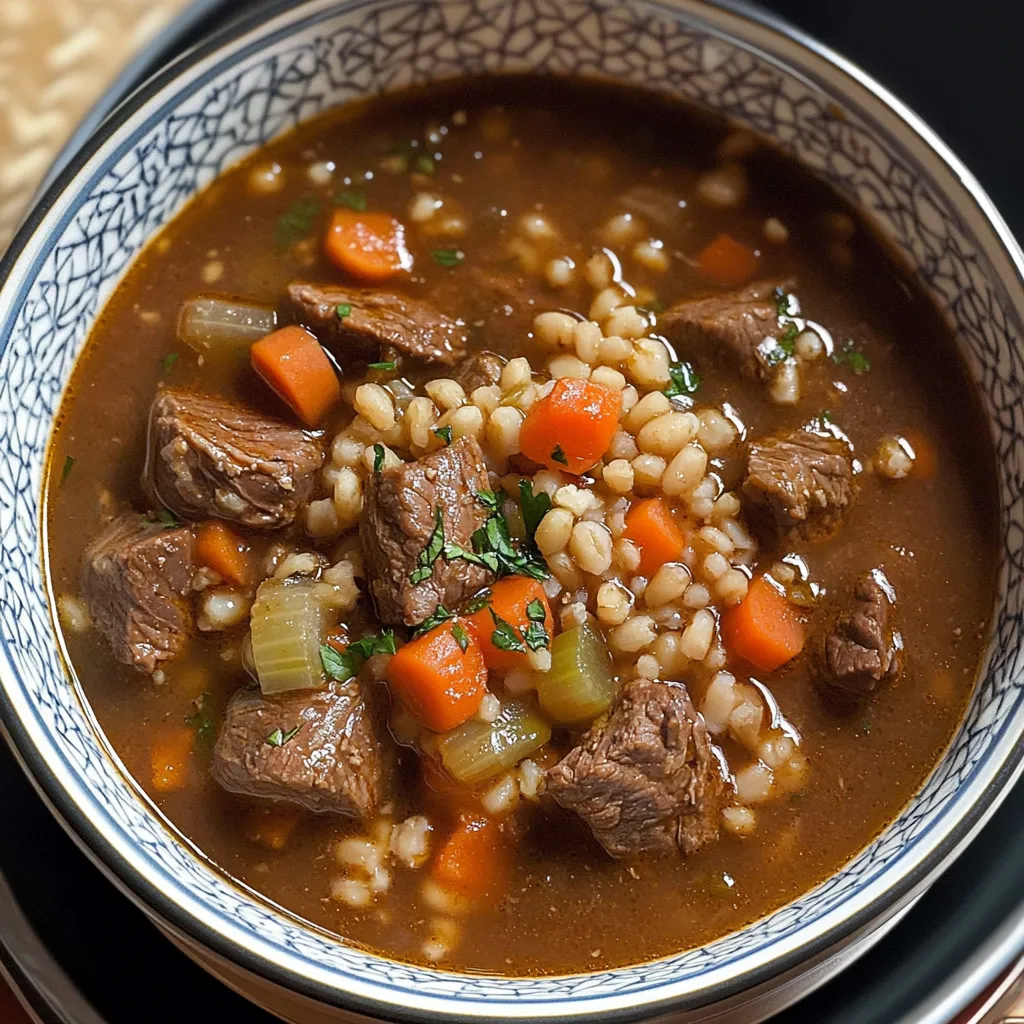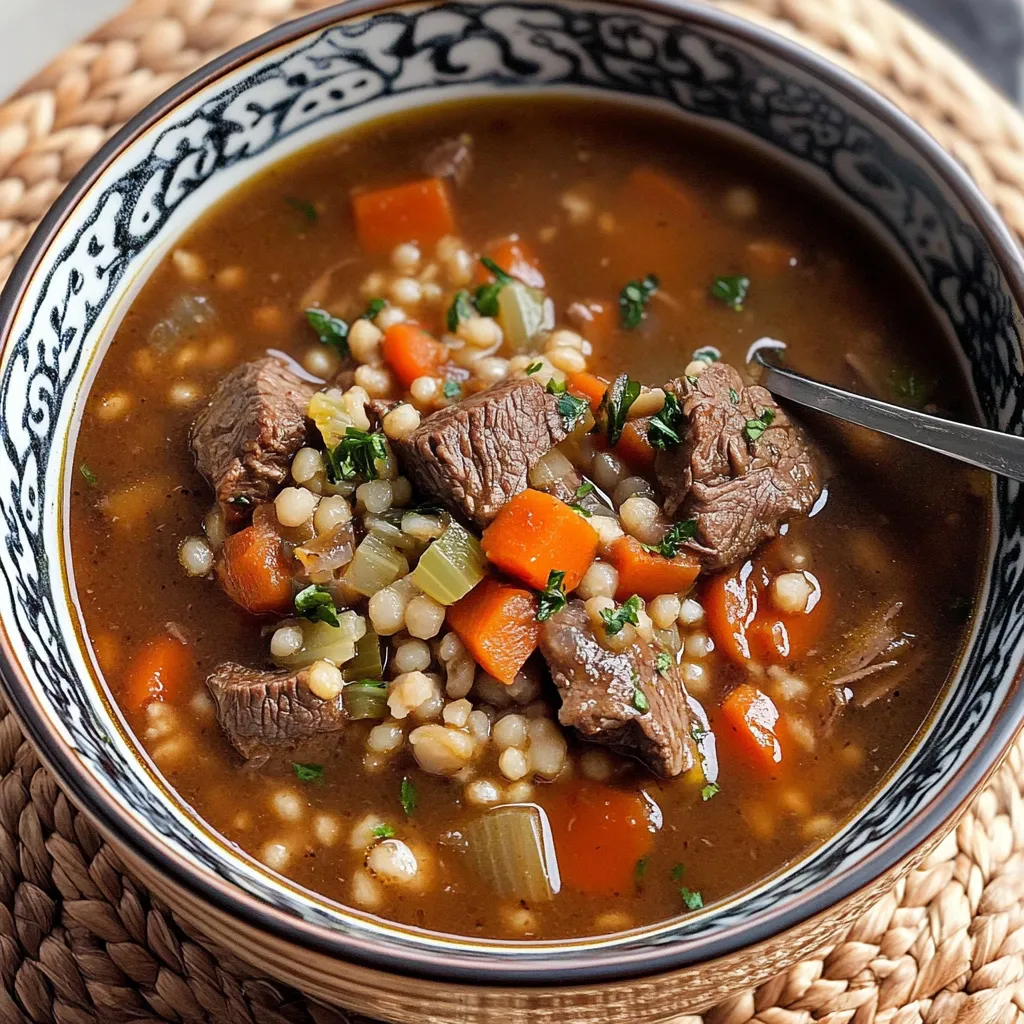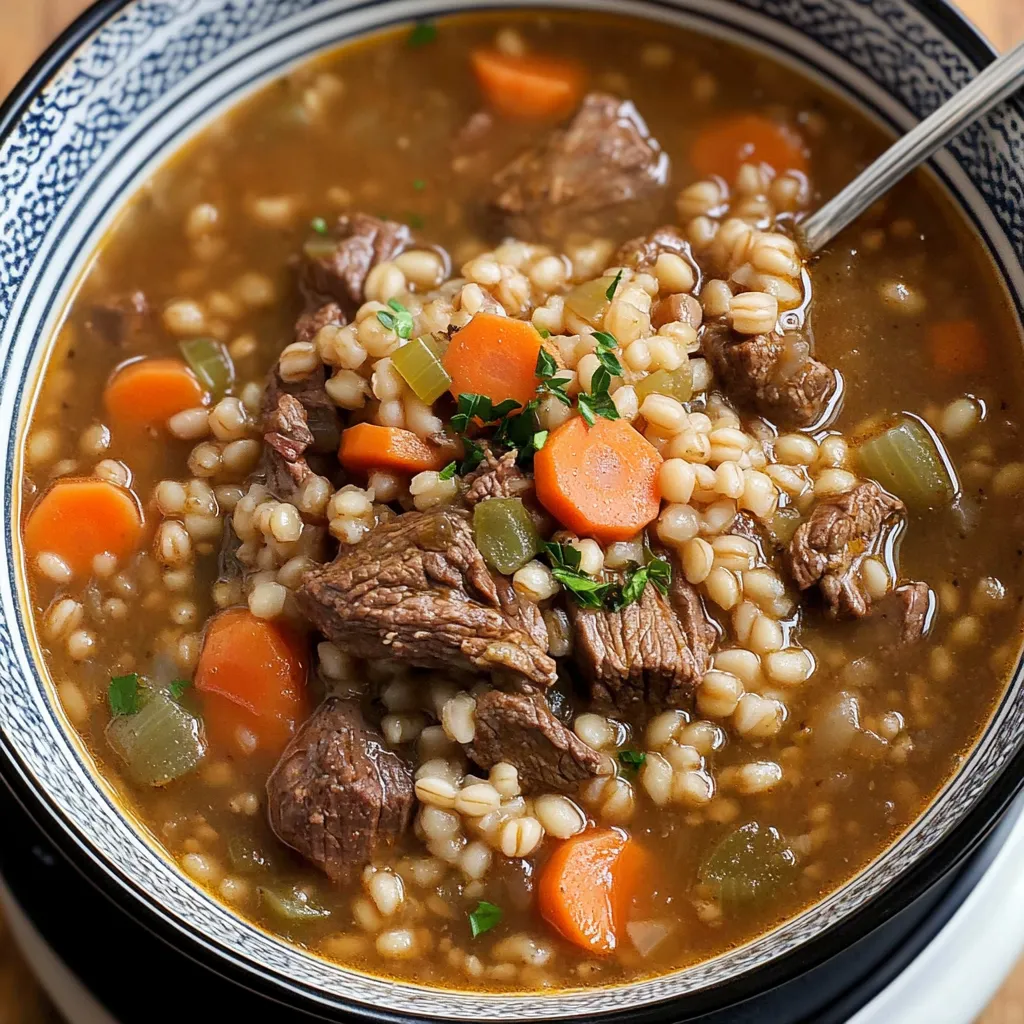 Pin it
Pin it
Picture a steaming pot of rich, mahogany-colored stew simmering on the stove, filling your kitchen with an irresistible aroma. This hearty beef barley stew combines tender chunks of beef, plump pearled barley, and garden-fresh vegetables in a rich, wine-infused broth. Each spoonful delivers the kind of warmth and satisfaction that only slow-cooked, homestyle cooking can provide.
Sometimes the simplest meals create the most lasting memories. This stew has become my go-to recipe for cold evenings when my family craves something substantial and comforting. The way the kitchen fills with savory aromas as it simmers brings everyone to the table with eager anticipation.
Simple Ingredient Selection
- Beef Chuck: Offers perfect marbling and becomes wonderfully tender during cooking. Choose well-marbled pieces with bright color.
- Pearled Barley: Adds delightful texture and natural thickening. Select fresh barley with uniform, creamy-colored grains.
- Red Wine: Enriches the broth with complex flavors. A medium-bodied wine works beautifully.
- Fresh Vegetables: Provide color and nutrition. Choose firm carrots, crisp celery, and unblemished onions.
- Beef Broth: Forms the foundation. Homemade delivers superior results, but quality store-bought works well.
Creating Perfect Stew
- Meat Preparation:
- Pat beef cubes completely dry. Season generously with salt and pepper. Heat pot until properly hot and sear meat until deeply browned.
- Vegetable Foundation:
- Sauté onions until translucent. Add carrots and celery, cooking until vegetables soften. Incorporate minced garlic.
- Building Flavors:
- Deglaze pot with red wine, scraping up browned bits thoroughly. Return beef to pot, add broth, and seasonings.
- Final Development:
- Stir in pearled barley and maintain a gentle simmer. Check meat and barley tenderness, adjusting seasoning thoughtfully.
The art of making beef barley stew has been passed down through generations in my family. My grandmother taught me the importance of taking time with each step, especially the initial searing of the meat. Those early kitchen lessons showed me how patience and attention to detail transform simple ingredients into something truly special.
Perfect Meal Companions
Present this robust stew alongside crusty sourdough bread or warm dinner rolls for soaking up every drop of the flavorful broth. A crisp green salad dressed with light vinaigrette provides refreshing contrast to the rich stew. For special occasions, I serve it in bread bowls, which never fails to impress guests. The combination of tender beef, chewy barley, and fresh bread creates an unforgettable dining experience.
 Pin it
Pin it
Customizing Your Stew
Transform this versatile recipe to suit various preferences and dietary needs. Add mushrooms for extra earthiness and umami flavor. Incorporate parsnips or turnips for additional root vegetable variety. For a lighter version, use lean beef and increase the vegetable content. During summer months, fresh herbs from the garden like thyme and rosemary add bright notes. My family particularly enjoys when I add pearl onions during the last hour of cooking.
Preserving Your Creation
Allow stew to cool completely before transferring to airtight containers. This hearty dish maintains its wonderful flavor and texture for up to five days when properly refrigerated. For longer storage, portion into freezer-safe containers, leaving room for expansion. When reheating, warm slowly over medium-low heat, stirring occasionally. Add beef broth if needed to achieve desired consistency, as barley continues absorbing liquid.
Professional Kitchen Wisdom
- Allow meat to reach room temperature before searing for optimal browning and tenderness.
- Layer seasonings throughout the cooking process rather than adding all at once.
- Trust your instincts with cooking time, as different cuts of meat may require longer simmering.
Creating this stew reminds me that good cooking requires both patience and presence. The process of building flavors step by step results in a dish that truly nurtures those gathered around your table.
Weekend Preparation Tips
Make this stew your weekend cooking project, allowing aromas to fill your home throughout the afternoon. Prep all ingredients before starting, creating an organized workspace. Consider making a double batch, freezing portions for busy weeknights. The investment of time pays dividends in future meals ready to enjoy.
Seasonal Adaptations
While perfect for cold weather, this stew adapts beautifully throughout the year. Spring versions welcome fresh peas and tender herbs. Summer stews can incorporate fresh garden vegetables. Autumn brings the opportunity to add butternut squash or sweet potatoes. Each season offers unique ingredients to keep this classic dish exciting.
Nutritional Benefits
Beyond its comforting qualities, this stew provides excellent nutrition. Barley offers beneficial fiber and protein, while vegetables contribute essential vitamins and minerals. The slow cooking method makes nutrients more accessible and creates easily digestible proteins from the beef.
 Pin it
Pin it
This beef barley stew represents comfort food at its finest. Through years of making it for family and friends, I've discovered that its appeal lies not just in its hearty flavors but in its ability to bring people together around the table. The recipe proves that time-honored cooking methods and quality ingredients create meals that nourish both body and soul.
Frequently Asked Questions
- → What's the best cut of beef for this stew?
- Chuck roast, shoulder, stew meat, or brisket work best. These cuts become tender and flavorful when slowly cooked in the stew.
- → Can I make this stew ahead of time?
- Yes, it keeps well in the fridge for 3-4 days. The barley will continue to absorb liquid, so you may need to add more broth when reheating.
- → Can I freeze beef barley stew?
- Yes, freeze for up to 3 months. Slightly undercook the barley before freezing so it won't get mushy when reheated.
- → What can I substitute for the red wine?
- Replace the wine with 3 ounces of tomato paste to add richness and depth to the stew.
- → How do I know when the stew is done?
- The stew is ready when both the beef chunks are tender and the barley is cooked through, usually after 1-1.5 hours of simmering.
